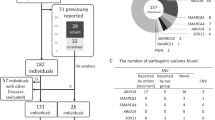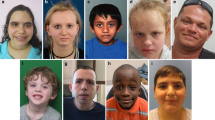Abstract
Nicolaides-Baraitser syndrome (NBS) is characterized by sparse hair, distinctive facial morphology, distal-limb anomalies and intellectual disability. We sequenced the exomes of ten individuals with NBS and identified heterozygous variants in SMARCA2 in eight of them. Extended molecular screening identified nonsynonymous SMARCA2 mutations in 36 of 44 individuals with NBS; these mutations were confirmed to be de novo when parental samples were available. SMARCA2 encodes the core catalytic unit of the SWI/SNF ATP-dependent chromatin remodeling complex that is involved in the regulation of gene transcription. The mutations cluster within sequences that encode ultra-conserved motifs in the catalytic ATPase region of the protein. These alterations likely do not impair SWI/SNF complex assembly but may be associated with disrupted ATPase activity. The identification of SMARCA2 mutations in humans provides insight into the function of the Snf2 helicase family.
This is a preview of subscription content, access via your institution
Access options
Subscribe to this journal
Receive 12 print issues and online access
$209.00 per year
only $17.42 per issue
Buy this article
- Purchase on Springer Link
- Instant access to full article PDF
Prices may be subject to local taxes which are calculated during checkout


Similar content being viewed by others
References
Nicolaides, P. & Baraitser, M. An unusual syndrome with mental retardation and sparse hair. Clin. Dysmorphol. 2, 232–236 (1993).
Sousa, S.B. et al. Nicolaides-Baraitser syndrome: delineation of the phenotype. Am. J. Med. Genet. A. 149A, 1628–1640 (2009).
Flaus, A., Martin, D.M., Barton, G.J. & Owen-Hughes, T. Identification of multiple distinct Snf2 subfamilies with conserved structural motifs. Nucleic Acids Res. 34, 2887–2905 (2006).
Hargreaves, D.C. & Crabtree, G.R. ATP-dependent chromatin remodeling: genetics, genomics and mechanisms. Cell Res. 21, 396–420 (2011).
Liu, G. et al. Two novel BRM insertion promoter sequence variants are associated with loss of BRM expression and lung cancer risk. Oncogene 30, 3295–3304 (2011).
Magnani, L. & Cabot, R.A. Manipulation of SMARCA2 and SMARCA4 transcript levels in porcine embryos differentially alters development and expression of SMARCA1, SOX2, NANOG, and EIF1. Reproduction 137, 23–33 (2009).
Reisman, D., Glaros, S. & Thompson, E.A. The SWI/SNF complex and cancer. Oncogene 28, 1653–1668 (2009).
Christ, L.A., Crowe, C.A., Micale, M.A., Conroy, J.M. & Schwartz, S. Chromosome breakage hotspots and delineation of the critical region for the 9p-deletion syndrome. Am. J. Hum. Genet. 65, 1387–1395 (1999).
Bultman, S. et al. A Brg1 null mutation in the mouse reveals functional differences among mammalian SWI/SNF complexes. Mol. Cell 6, 1287–1295 (2000).
Khavari, P.A., Peterson, C.L., Tamkun, J.W., Mendel, D.B. & Crabtree, G.R. BRG1 contains a conserved domain of the SWI2/SNF2 family necessary for normal mitotic growth and transcription. Nature 366, 170–174 (1993).
Richmond, E. & Peterson, C.L. Functional analysis of the DNA-stimulated ATPase domain of yeast SWI2/SNF2. Nucleic Acids Res. 24, 3685–3692 (1996).
Hall, M.C. & Matson, S.W. Helicase motifs: the engine that powers DNA unwinding. Mol. Microbiol. 34, 867–877 (1999).
de La Serna, I.L. et al. Mammalian SWI-SNF complexes contribute to activation of the hsp70 gene. Mol. Cell Biol. 20, 2839–2851 (2000).
Subramanya, H.S., Bird, L.E., Brannigan, J.A. & Wigley, D.B. Crystal structure of a DExx box DNA helicase. Nature 384, 379–383 (1996).
Dürr, H., Flaus, A., Owen-Hughes, T. & Hopfner, K.P. Snf2 family ATPases and DExx box helicases: differences and unifying concepts from high-resolution crystal structures. Nucleic Acids Res. 34, 4160–4167 (2006).
Boerkoel, C.F. et al. Mutant chromatin remodeling protein SMARCAL1 causes Schimke immuno-osseous dysplasia. Nat. Genet. 30, 215–220 (2002).
Vissers, L.E. et al. Mutations in a new member of the chromodomain gene family cause CHARGE syndrome. Nat. Genet. 36, 955–957 (2004).
Bajpai, R. et al. CHD7 cooperates with PBAF to control multipotent neural crest formation. Nature 463, 958–962 (2010).
Li, H. & Durbin, R. Fast and accurate short read alignment with Burrows-Wheeler transform. Bioinformatics 25, 1754–1760 (2009).
Li, H. et al. The Sequence Alignment/Map format and SAMtools. Bioinformatics 25, 2078–2079 (2009).
McKenna, A. et al. The Genome Analysis Toolkit: a MapReduce framework for analyzing next-generation DNA sequencing data. Genome Res. 20, 1297–1303 (2010).
Albers, C.A. et al. Dindel: accurate indel calls from short-read data. Genome Res. 21, 961–973 (2011).
Wang, K., Li, M. & Hakonarson, H. ANNOVAR: functional annotation of genetic variants from high-throughput sequencing data. Nucleic Acids Res. 38, e164 (2010).
Olabarriaga, S.D., Glatard, T. & de Boer, P.T. A virtual laboratory for medical image analysis. IEEE Trans. Inf. Technol. Biomed. 14, 979–985 (2010).
Liu, X., Jian, X. & Boerwinkle, E. dbNSFP: a lightweight database of human non-synonymous SNPs and their functional predictions. Hum. Mutat. 32, 894–899 (2011).
Acknowledgements
We thank the Genome of the Netherlands Project (GoNL) for providing their variant data. GoNL is one of the rainbow projects of the Dutch hub of the Biobanking and Biomolecular Research Infrastructure (BBMRI-NL). We thank S. Olabarriaga and M. Santcroos for their support in using the Dutch Grid for data analysis. We thank T.J.L. de Ravel and P. Brady for critical reading of the manuscript and G. Peeters for technical support. We are grateful to the subjects and their families for participating in this study. This work was made possible by grants from the Agency for Innovation by Science and Technology (IWT; SBO-60848), the Catholic University of Leuven (PFV/10/016 SymBioSys and GOA/12/015 to J.R.V., Y.M. and K.D.), the Queen Elisabeth Medical Foundation (GSKE 1113 to D. Hu and E.S.) and the type 3 large-infrastructure support InfraMouse by the Flanders Hercules Foundation (to D. Hu). B.A.N. is supported by a KOLUMB fellowship from the Foundation for Polish Science. S.B.S. was supported by the Fundação Para a Ciência e Tecnologia (SFRH/BD/46778/2008).
Author information
Authors and Affiliations
Contributions
J.R.V., K.D., R.H. and S.B.S. designed the experiments. J.K.J.V.H., A.S., Y.M., A.H.C.v.K. and B.D.C.v.S. performed bioinformatic analyses. S.B.S. and R.H. collected the study subjects. B.A.N. performed the sequencing. E.S. and D. Hu performed immunostaining. B.A.N., N.A. and P.v.D. performed functional studies. O.A.A.-R., M.-J.H.v.d.B., A.B., M.C., V.C.-D., M.A.D., I.F., A.F., J.-P.F., L.G., S.G., G.G.-K., B.D.H., D. Ho, J.K., M.K.-W., A.K., K.D.M., M.A.L., S. Maas, S. McKee, A.M., S.A.d.M., F.M.-P., E.O., J.P., E.R., N.S., I.S.-D., C.V., A.V., E.W., D.W., L.W., O.Z., K.D. and R.H. contributed clinical cases and clinical data for the study. B.A.N., J.K.J.V.H., S.B.S., K.D., R.H. and J.R.V. wrote the manuscript.
Corresponding authors
Ethics declarations
Competing interests
The authors declare no competing financial interests.
Supplementary information
Supplementary Text and Figures
Supplementary Tables 1 and 2 and Supplementary Figures 1 and 2 (PDF 6545 kb)
Rights and permissions
About this article
Cite this article
Van Houdt, J., Nowakowska, B., Sousa, S. et al. Heterozygous missense mutations in SMARCA2 cause Nicolaides-Baraitser syndrome. Nat Genet 44, 445–449 (2012). https://doi.org/10.1038/ng.1105
Received:
Accepted:
Published:
Issue Date:
DOI: https://doi.org/10.1038/ng.1105
This article is cited by
-
Landscape of mSWI/SNF chromatin remodeling complex perturbations in neurodevelopmental disorders
Nature Genetics (2023)
-
Neurodevelopmental disorders, like cancer, are connected to impaired chromatin remodelers, PI3K/mTOR, and PAK1-regulated MAPK
Biophysical Reviews (2023)
-
SWI/SNF chromatin remodeler complex within the reward pathway is required for behavioral adaptations to stress
Nature Communications (2022)
-
Brahma safeguards canalization of cardiac mesoderm differentiation
Nature (2022)
-
Maternal transmission of a mild Coffin–Siris syndrome phenotype caused by a SOX11 missense variant
European Journal of Human Genetics (2022)



